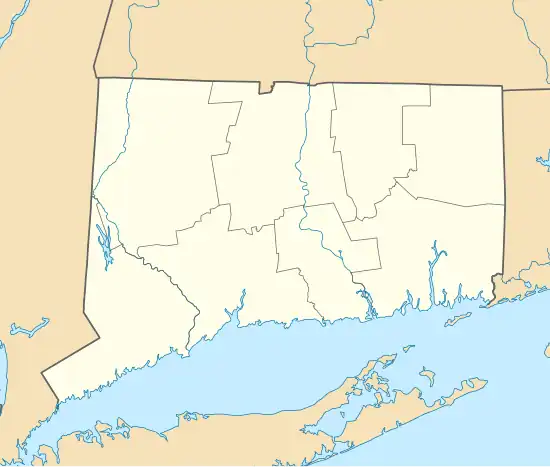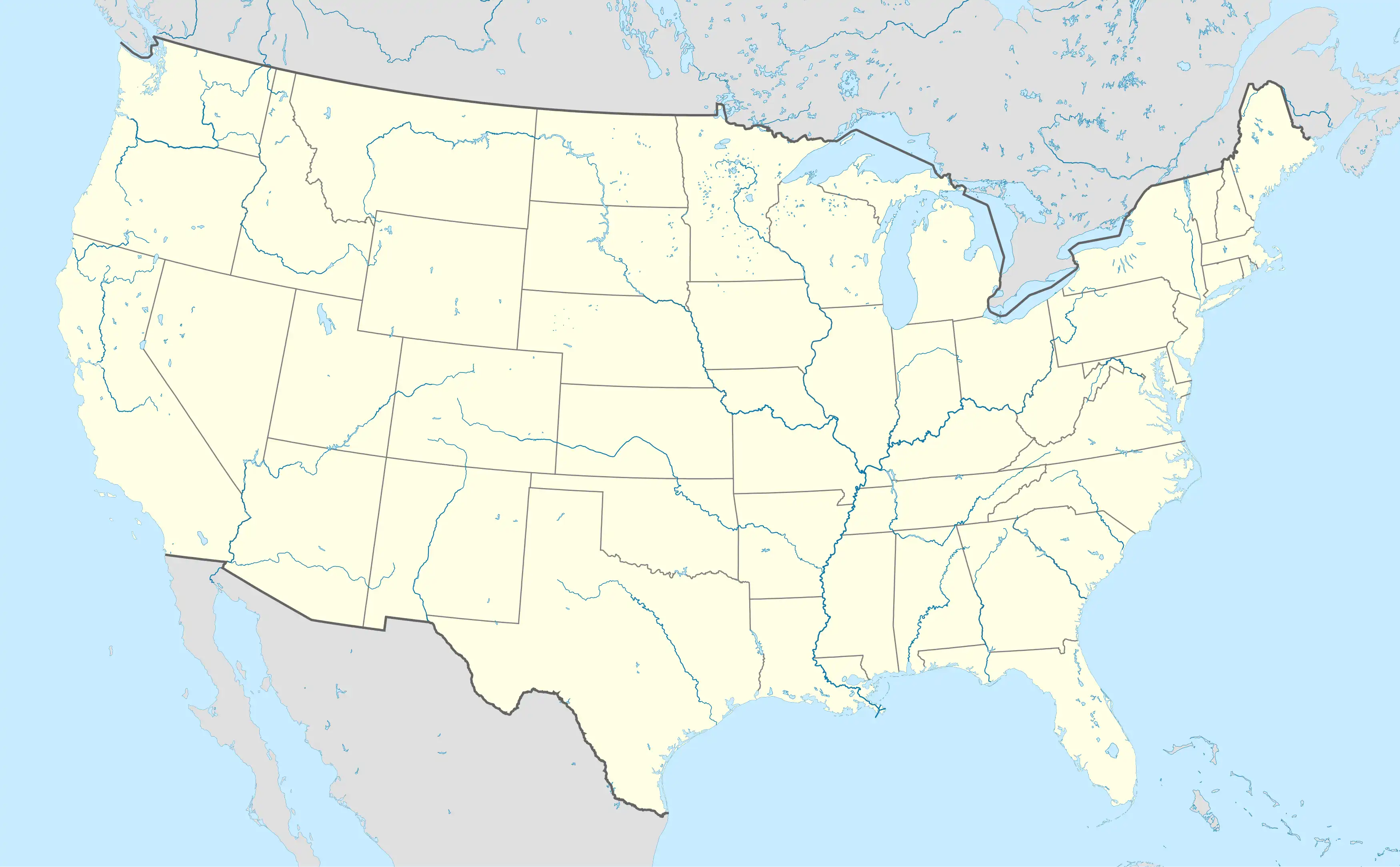Morris Greenwald House
Morris Greenwald House | |
 | |
  | |
| Nearest city | Weston, Connecticut |
|---|---|
| Coordinates | 41°11′51.955″N 73°21′25.894″W / 41.19776528°N 73.35719278°W |
| Built | 1955 |
| Architect | Ludwig Mies van der Rohe |
| Architectural style | International Style |
| NRHP reference No. | MP100010953 |
| Added to NRHP | October 28, 2024[1] |
The Morris and Rose Greenwald House (also the Morris Greenwald House) is a historical house in Weston, Connecticut, US, designed and built in 1955 by German architect Ludwig Mies van der Rohe. The house was constructed as a single-story primary residence in Weston, roughly 45 miles (72 km) northeast of New York City. The brick, steel, and glass residence was commissioned by Morris Greenwald for himself and his wife. Since 1981, it has been owned by Richard and Jane Wolf.
The structure created by Mies is a late rendition of the International Style, and is recognized internationally as a strong example of "less is more", a common phrase Mies stood by in all of his design choices throughout his career. On October 28, 2024, the house was entered into the National Register of Historic Places by the National Park Service. Since its completion, the house, being one of the only 3 residences build by Mies in the United States, is the only one to remain a private residence.
History
Ludwig Mies van der Rohe was attained by Morris Greenwald through his brother, Herbert Greenwald, who was business partners with Mies from 1946 until Greenwald's untimely death in 1959. Mies, having manufactured an excess amount of window-walls for the 860–880 Lake Shore Drive Apartments, based his concept of the Morris Greenwald House around experimenting with the relationship between modular systems and residential structures. The house was completed in 1955, and was the residence of Morris and Rose Greenwald for roughly 25 years.
In 1960, the house was extended by Mies, adding a second bedroom for unknown reasons. It is hypothesized that the master bedroom was too revealing and provided lesser privacy than anticipated, which initiated an extension project to satisfy needs. This would be the last time that Ludwig Mies van der Rohe was involved with any additions to the Morris Greenwald House.
New owners
Within the late 1970s and early 1980s, Morris and Rose Greenwald put the house up for sale, and by 1981, it was sold to Richard and Jane Wolf, would then go on to make multiple changes and additions to the house under American Architectural Firm Peter L. Gluck and Associates (now known as GLUCK+). In 1982, they added two pavilions and a pool to the property. In 1989, the plan was changed from its original orientation into an L-shaped structure, which included a master suite and enlarged kitchen and dining areas. The most recent and final renovation thus far was conducted in 2003, which added a new "outrigger", adding a master suite with a separate pool pavilion and guesthouse. Each of these renovations aimed at staying true to what Mies had built, only extending upon the structure to accommodate the requests of Richard and Jane Wolf.
Architecture
Exterior
The plans made by Ludwig Mies van der Rohe are a common yet strong example of his "skin and bones" approach to designing structures. The building itself was originally designed as a simple living quarters, only featuring a master bedroom, kitchen, dining area, bathroom, and few closets for storage. The building itself is primarily made of brick, steel, and glass, featuring the modular systems from the Lake Shore Drive apartments as the connection between the indoors and surrounding nature. Similar to other works of Mies, structural components are steel I-beams to accommodate for the lack of walls, allowing for the extensive use of glass walls and curtain walls where needed for privacy. The house avoids excessive ornamentation, furthering Mies' "less is more" philosophy, and is a strong example of Mies' use of the International style for residential projects. In 1960, Mies extended the house, adding more space to the structure as a whole, being Mies' last contribution to the residence as a whole.
After 1981, Peter L. Gluck and Associates changed very little to the overall style of the residence, only adding large additions such as the master suite, the guesthouse, and the pools. Staying true to what Mies had created, the additional structures only built upon the vision through residential accessories, an example being the full-height glass screen doors that use tracks to slide into pockets, allowing for the spaces to be fully exposed to nature when open.
Interior
The interior of the residence has strong correlations with the exterior, avoiding ornamentation and using excessive amounts of glass to strengthen the relationship between the indoors and nature. As commonly seen in Mies' residences, privacy is scarce, with nature being the only barrier between the public and the home itself. The home instills a very open plan, providing for lots of movement and changes. Isolated rooms and elements only include the bathroom and kitchen utilities along with a central fireplace made of travertine and steel arranged in the living area.
The renovations of the residence saw the addition of an entertainment space, guest quarters, and expansions to the kitchen and dining space. Peter L. Gluck and Associates did not change the openness of the floor plan, which was a staple of Mies' residential designs.
A Weston home
Ludwig Mies van der Rohe, having designed residences through his entire career, had only designed and constructed 3 residential projects within the United States, one of which being the Morris Greenwald House. The other two, the Farnsworth House in Plano, Illinois and the Robert H. McCormick House in Elmhurst, Illinois, have been altered into museums to showcase the legacy of Mies and his impact on American architecture. Not only does this make the Morris Greenwald House the only residence on the East Coast, and the last remaining Mies house that is still occupied as a private residence, not open to the public.
When Mies designed the residence in the 1950s, it was intended to be a residence, like his other residential projects. However, due to his popularity as an architect defining the early 1900s through his international style, many of his projects have been turned into museums to commemorate his legacy. The fact that the Morris Greenwald House is still privately owned and used as a residence for its current owners preserves Mies' intentions to design and construct a residence to be used as a living quarters, which is rare amongst all famous works made by numerous influential architects throughout history.
See also
- National Register of Historic Places listings in Fairfield County, Connecticut
- Barcelona Pavilion
- 860–880 Lake Shore Drive Apartments
- S. R. Crown Hall
References
- ^ Cite error: The named reference
nriswas invoked but never defined (see the help page).
External links
- GLUCK+
- December 31, 2024 | by Ted Craft. "Weston Home a National Historic Place." Weston Today, Accessed 21 July 2025.
- Waldek, Stefanie. "Inside the Most Comprehensive Compendium of Midcentury-Modern Architecture Ever." Architectural Digest, 21 Nov. 2019, Accessed 21 July 2025.
- moderndesigninterior, Mies Van Der Rohe Morris Greenwald, Blogger, 27 Mar. 2012, Accessed 21 July 2025.
- Peter L. Gluck. Herbert Greenwald. GLUCK+. Bradbury, Dominic. Atlas of Mid-Century Modern Houses. Phaidon Press(PDF), 2019 (excerpt). Accessed 21 July 2025.
- 10-900 Registration Form(PDF). "National Register Information System". National Register of Historic Places. National Park Service. Accessed 9 July 2025.
- "Morris Greenwald House." Mies van Der Rohe Society, 30 June 2021, Accessed 21 July 2025.